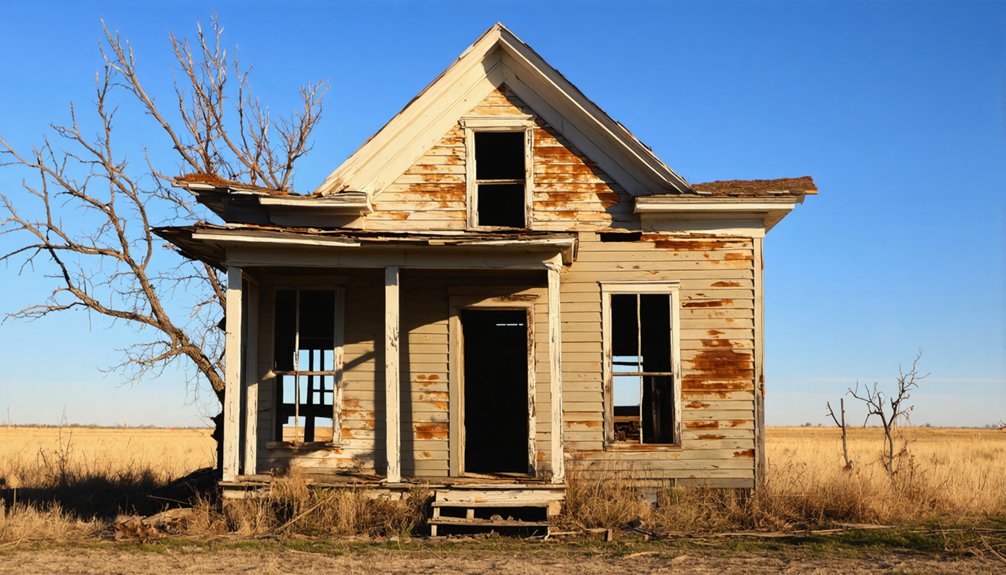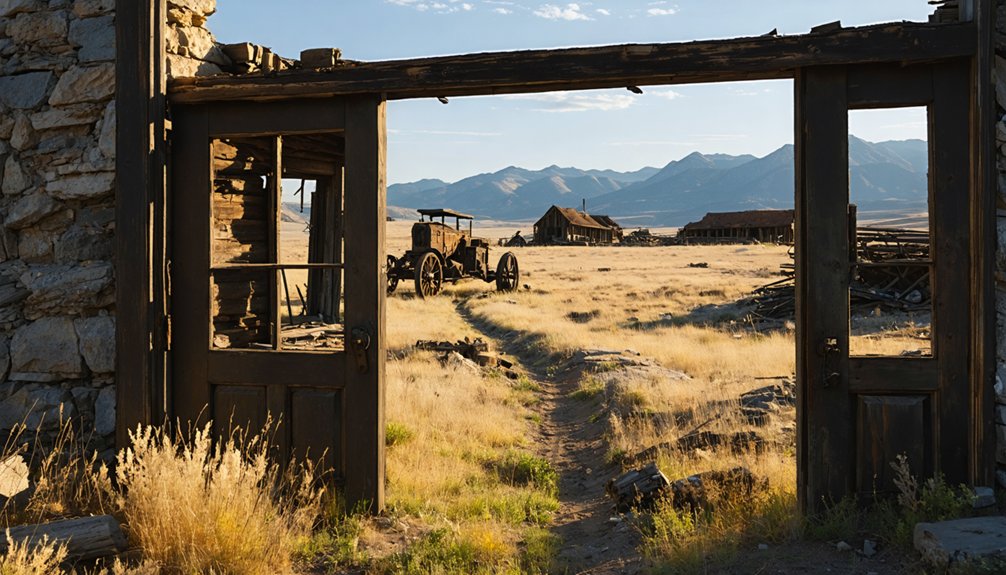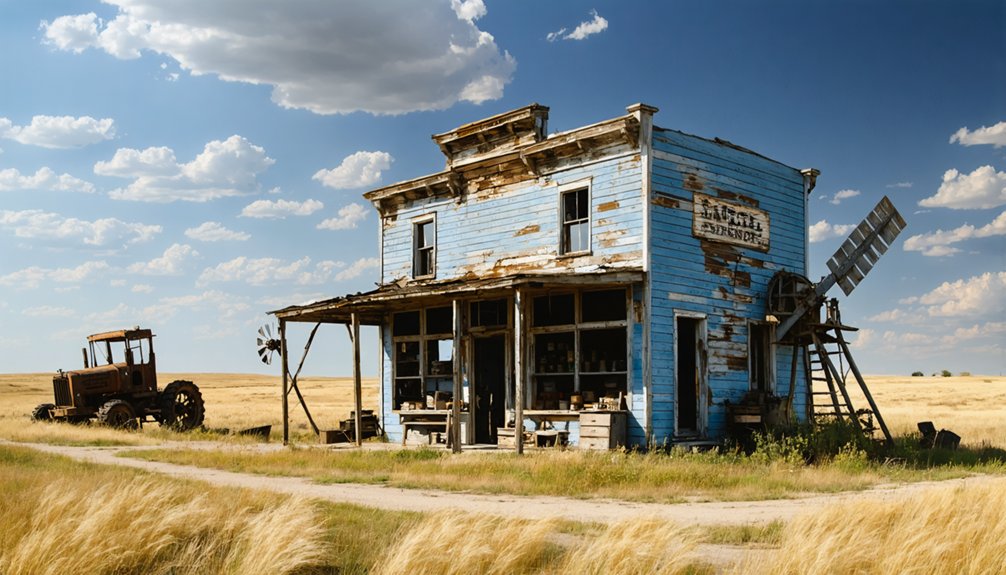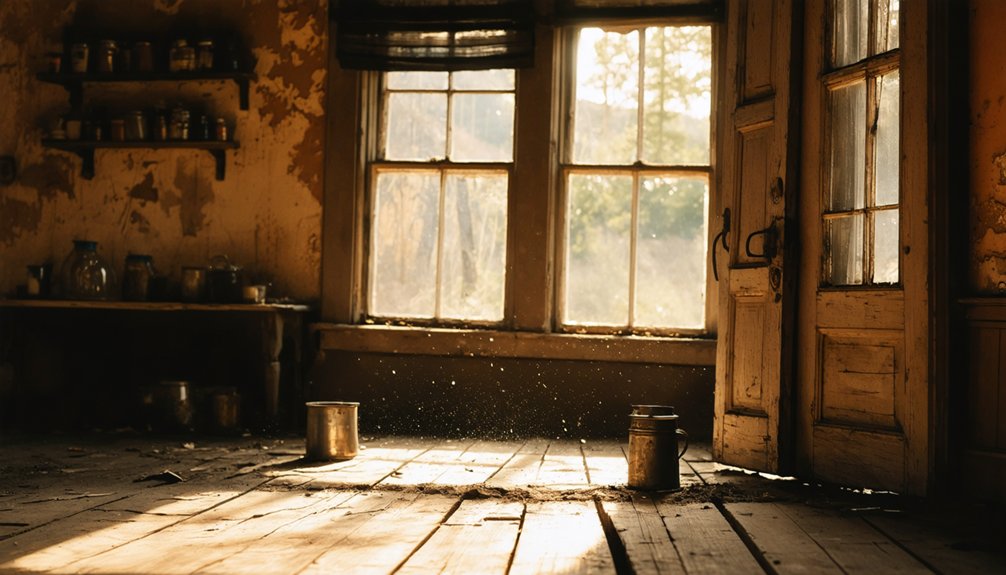You’ll find Minnelusa’s ruins nestled in South Dakota’s Black Hills, where it once thrived as a promising mining settlement during the 1870s gold rush. The town’s fate shifted dramatically when Seth Bullock, a prominent figure in Dakota Territory politics, routed the railroad through Belle Fourche instead of Minnelusa. Today, you can explore weathered foundations, a roofless chapel, and old mining shafts that tell the story of frontier ambitions and railroad politics that shaped the American West.
Key Takeaways
- Minnelusa became a ghost town after Seth Bullock strategically routed the railroad through Belle Fourche instead, causing economic decline.
- The town’s ruins include a roofless chapel, mining shaft remnants, and weathered foundations that mark its former presence.
- Economic instability led to closure of essential services and population decline as younger generations migrated to urban centers.
- Archaeological research camps continue to uncover artifacts that provide insights into the daily life of Minnelusa’s former residents.
- The town initially thrived during the Great Dakota Boom but lost its prominence when railroad development favored nearby Sturgis.
The Rise of a Black Hills Mining Settlement
Although the discovery of gold in French Creek during Custer’s 1874 expedition violated the Fort Laramie Treaty, it sparked an unstoppable rush that would transform the Black Hills forever.
As word spread, prospectors flocked to the region, staking claims along Deadwood and Whitewood Creeks by 1876. The initial gold rush centered around placer mining, with fortune seekers scouring creek beds for surface deposits. By the end of 1875, four thousand settlers had already established themselves illegally in the area. The San Francisco investors led by George Hearst would soon purchase the lucrative Homestake claim for $70,000.
By 1876, gold-hungry miners swarmed Deadwood and Whitewood Creeks, searching the waters for nature’s glittering treasures.
When these easy-to-access placer deposits began to dwindle, miners turned their attention to locating hard rock sources. The most significant discovery came in April 1876 when the Manuel brothers, along with Harney and Engh, found what would become the Homestake Claim near Lead.
This discovery shifted the region’s mining focus northward, leading to the rapid establishment of settlements that would support the booming industry.
Seth Bullock’s Influence on Minnelusa’s Fate
When you look at Minnelusa’s decline, you’ll find Seth Bullock’s railroad politics played a decisive role in the town’s fate.
As a shrewd businessman and former Deadwood sheriff, Bullock leveraged his influence to route the railroad through his newly established town of Belle Fourche instead of Minnelusa. His fearless leadership style helped him navigate the complex political landscape of railroad development.
His strategic maneuvering not only secured Belle Fourche’s future but also contributed to Deadwood’s growing dominance as the region’s economic powerhouse, effectively sealing Minnelusa’s destiny as a future ghost town. The impact was particularly significant as Belle Fourche became the largest livestock railhead in the United States.
Railroad Politics and Power
Through shrewd political maneuvering and strategic land investments, Seth Bullock orchestrated Minnelusa’s eventual decline by redirecting the region’s economic center to Belle Fourche in the late 1880s.
As a powerful sheriff and businessman, he knew railroad expansion would determine which towns thrived in the frontier economy. His experience running a successful hardware store in Deadwood helped him understand the vital role of transportation and commerce in town development. He later expanded his ventures by offering 40 acres of land to the railroad company for development.
You’ll find Bullock’s masterful control of regional development unfolded through these key moves:
- Negotiated free railroad routing through his S&B Ranch land
- Offered free lots to businesses willing to relocate from Minnelusa
- Leveraged his political connections with Governor Pennington to secure favorable infrastructure projects
- Established Belle Fourche as America’s largest livestock shipping point
This calculated strategy transformed Belle Fourche into a bustling railroad hub while sealing Minnelusa’s economic decline into obscurity.
Deadwood’s Rising Dominance
As Seth Bullock stepped into his role as Lawrence County Sheriff in 1877, his commanding presence began reshaping Deadwood’s destiny – and by extension, Minnelusa’s fate.
Through his partnership with Sol Star and their successful hardware business, Bullock helped establish Deadwood’s commercial dominance in the region. His work as fire chief in organizing Deadwood’s first fire department demonstrated his commitment to the town’s safety and growth. You’ll find that their ventures, including the landmark Bullock Hotel, drew resources and settlers away from smaller settlements like Minnelusa.
Bullock’s ability to maintain order without bloodshed made Deadwood increasingly attractive to investors and families seeking stability. His establishment of the first hotel in Deadwood in 1896 further cemented the town’s position as a regional hub.
His political influence and development of Belle Fourche further concentrated power in these growing hubs, leading to community displacement as Minnelusa’s significance waned.
The very success of Bullock’s law enforcement and business endeavors in Deadwood ultimately contributed to Minnelusa’s ghost town status.
Life in a Frontier Mining Community
You’d find frontier mining life in Minnelusa revolved around the grueling daily challenges of extracting precious metals while maintaining a household in harsh conditions.
Mining families formed tight social bonds, creating support networks that helped them weather everything from equipment breakdowns to harsh winters in the Black Hills. The community was part of the region’s gold production districts that stretched across Lawrence and Pennington counties.
Your social standing often depended on both your role in the mining operations and your family’s ability to contribute to community needs through shared resources and labor. The residents often gathered for Chuck Wagon Lunch events where they could socialize and share news about mining operations.
Daily Living Challenges
Life in frontier mining communities like Minnelusa demanded remarkable resilience from residents who faced harsh isolation and limited resources. Your daily struggles would test even the hardiest pioneer spirit as you’d confront:
- Finding shelter in hastily built wooden cabins or tents, often sharing cramped spaces with other families while constantly gathering firewood to ward off the brutal Dakota winters.
- Securing food through a mix of hunting, expensive general store supplies, and creative survival tactics when shipments couldn’t reach the remote settlement.
- Managing health concerns without proper medical care, relying on home remedies while facing risks from mining accidents and disease outbreaks.
- Dealing with contaminated water sources from mining operations, making even basic hygiene and drinking water a constant challenge.
Family Social Networks
Within frontier mining communities like Minnelusa, family networks formed the bedrock of social stability and survival.
You’d find extended families creating webs of support that stretched across multiple households, sharing resources and labor to weather economic uncertainties. These family dynamics shaped every aspect of daily life, from strategic marriages that strengthened community ties to informal credit systems that helped families navigate tough times.
Community resilience emerged through social gatherings at church halls and schools, where you’d join neighbors for dances, community dinners, and celebrations of mining successes.
When hardship struck – whether illness, injury, or death in the mines – mutual aid groups quickly mobilized support.
Women’s home enterprises and children’s contributions to both domestic and mining tasks reinforced these intricate networks of interdependence.
Economic Boom and Railroad Politics
Railroad fever gripped Minnelusa during the Great Dakota Boom, as the Minneapolis & St. Louis Railway brought unprecedented economic impact to the region.
The arrival of the Minneapolis & St. Louis Railway transformed Minnelusa from a quiet prairie town into a booming economic powerhouse.
The railroad expansion transformed this remote prairie outpost into a bustling hub of activity, attracting waves of ambitious settlers and entrepreneurs.
You’ll find that four key developments shaped Minnelusa’s rapid growth:
- Merchants and laborers flooded the area, establishing new businesses near the tracks.
- Grain shipments became faster and more reliable, boosting local agricultural prospects.
- Land values soared as railroad companies platted new town sites.
- Competition between rival rail companies sparked intense development.
While the Milwaukee Road and Chicago & North Western dominated the broader region, it was the M&StL that put Minnelusa on the map, though the town’s fortunes would remain closely tied to the railroad’s success.
The Path to Abandonment

Despite its promising start as a bustling frontier town, Minnelusa’s descent into abandonment began when the railroad industry shifted its focus to nearby Sturgis.
You’ll find that community resilience wavered as the town lost its county seat status and crucial rail connections, causing businesses and skilled workers to seek opportunities elsewhere.
The population dynamics shifted dramatically as younger generations moved to growing urban centers and mining camps.
Without a stable economic foundation, essential services like schools and stores closed their doors.
Agricultural challenges, including poor soil and harsh weather, made it impossible for farming families to sustain themselves.
As buildings fell into disrepair and infrastructure crumbled, the remaining residents had little choice but to leave.
With no new industries emerging to replace the lost railway commerce, Minnelusa faded into ghost town status.
Remnants and Ruins Today
Today’s visitors to Minnelusa encounter a haunting landscape of weathered ruins and crumbling foundations, marking where this once-vibrant frontier town stood. For modern ruin exploration enthusiasts, the ghostly landscapes reveal the town’s slow surrender to nature.
Time stands silent among Minnelusa’s weathered ruins, where crumbling stones whisper stories of a frontier town lost to history.
You’ll discover these haunting remnants across the site:
- A roofless chapel stands as the most prominent landmark, its walls defying time.
- Scattered grave markers tell stories of the 1919 influenza outbreak.
- Mining shaft remnants dot the surrounding hills, hinting at the town’s industrial past.
- Former railroad grades, now converted to trails, wind through foundation stones and ash heaps.
Nature’s reclamation continues as flooding and vegetation gradually consume what’s left.
While local historical societies document Minnelusa’s legacy, the physical ruins remain largely untouched, slowly fading into the South Dakota landscape.
Mining Heritage and Historical Significance

Mining shaped Minnelusa’s destiny after prospectors discovered gold in the Black Hills during 1874-1875, setting off a chain reaction that transformed the region. The ghost town’s story mirrors the broader evolution of Black Hills mining techniques, from simple placer mining to complex hard rock operations requiring stamp mills and innovative extraction methods.
You’ll find Minnelusa’s heritage intertwined with the area’s dramatic shift from surface mining to deep shaft operations.
While the famous Homestake Mine in nearby Lead endured for 126 years, most local mines couldn’t survive past the early 1900s when surface deposits were depleted and operational costs soared.
The mining legacy lives on through environmental regulations and ongoing debates about resource extraction, reflecting the delicate balance between the region’s mining past and its conservation future.
Preservation Efforts and Documentation
The preservation of Minnelusa’s rich history rests in the hands of dedicated organizations and community members who work tirelessly to protect its remaining structures and stories.
Despite preservation challenges, South Dakota’s State Historic Preservation Office actively maintains inventories and supports restoration through various grant programs and tax incentives.
You’ll find the town’s legacy preserved through:
- Documentary projects like “Vanished South Dakota” that capture the town’s historical narrative
- Archaeological research camps that uncover artifacts and provide insights into daily life
- Local historical societies that maintain archives of documents and photographs
- Community-driven events and fundraisers that generate support for preservation efforts
Through public-private partnerships and community engagement, you can participate in keeping Minnelusa’s heritage alive for future generations to explore and understand.
The Legacy of a Lost Town

While Minnesela’s physical structures have long since vanished from Butte County’s landscape, its legacy endures as a poignant reminder of South Dakota’s dynamic settlement era.
You’ll find the town’s story woven into the broader narrative of the American West, where railroad expansion and economic shifts shaped the destinies of countless communities.
Today, Minnesela’s cultural memory lives on through local historians and enthusiasts who preserve its tales.
Local storytellers and history keepers breathe life into Minnesela’s past, ensuring its memory endures through time.
As one of South Dakota’s many ghost towns, it draws attention from those fascinated by abandoned settlements, contributing to ghost town tourism in the region.
The town’s evolution from county seat to abandonment mirrors similar stories throughout the state, offering valuable insights into how changing transportation patterns and economic forces can reshape communities in the pursuit of progress.
Frequently Asked Questions
What Wildlife Species Now Inhabit the Abandoned Town Site?
You’ll spot wildlife adaptations from bison and pronghorns to prairie dogs and burrowing owls, all thriving in ghost town ecology alongside coyotes, mountain lions, and various eagles.
Are There Any Documented Paranormal Experiences From Minnelusa?
You won’t find documented ghost sightings or haunted history from Minnelusa, despite the Black Hills region’s rich paranormal lore. Historical records and paranormal investigations reveal no supernatural experiences from this forgotten town.
What Happened to the Town’s Original Cemetery?
You won’t find documented records of what happened to the original burial site, as historical data about Minnelusa’s cemetery has been lost to time, like many aspects of this ghost town.
Were Any Significant Gold Discoveries Made Specifically in Minnelusa?
You won’t find historical records of significant gold mining in Minnelusa itself. While the Black Hills Gold Rush brought tremendous discoveries nearby, Minnelusa’s limestone formation wasn’t a source of notable gold deposits.
Did Any Famous Outlaws Ever Visit or Hide in Minnelusa?
You won’t find evidence of famous outlaws in historical records there. Despite regional outlaw legends and hidden treasures in nearby Deadwood, no documented bandits ever used this location as refuge.
References
- https://www.youtube.com/watch?v=Glucs_Rq8Xs
- https://www.sdhspress.com/journal/south-dakota-history-2-2/some-black-hills-ghost-towns-and-their-origins/vol-02-no-2-some-black-hills-ghost-towns-and-their-origins.pdf
- https://www.youtube.com/watch?v=_0WNYsFLSLA
- https://www.sdpb.org/rural-life-and-history/2023-08-21/some-black-hills-ghost-towns-and-their-origins
- https://www.blackhillsbadlands.com/blog/post/old-west-legends-mines-ghost-towns-route-reimagined/
- https://www.youtube.com/watch?v=Fzt03lXwTNs
- https://en.wikipedia.org/wiki/List_of_ghost_towns_in_South_Dakota
- https://b1027.com/south-dakota-has-an-abundance-of-ghost-towns/
- https://blackhillsminingmuseum.com/learn/history
- https://history.sd.gov/museum/docs/LifeUnderground.pdf



